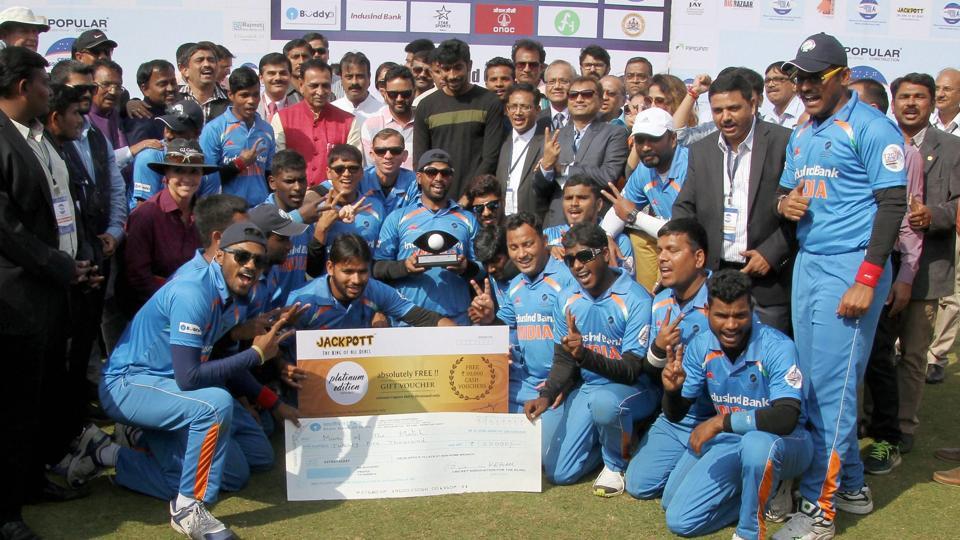All About How India Beat Pakistan To Win The T20 Blind World Cup
BENGALURU: There has been great celebration and jubilation about the Indian team winning the T20 Blind World Cup in Bengaluru on Sunday. However, little is known about the sport or India’s contribution to it.
Blind Cricket is an adapted version of the sport of cricket for individuals with visual impairment. The rules of the game are based on the standard game of cricket, but with modifications and other reasonable accommodations for individuals with visual impairment. With regard to the playing equipment, one of the main adaptations in the game is the ball – which is much larger than the standard cricket ball and is filled with ball bearings. This helps partially sighted players see the ball and provides player without sight auditory cues.
The stumps in blind cricket are larger and usually fluorescent in colour, so that partially sighted players are able to see them and those without sight are able to touch them to orient themselves while bowling or batting.
Unlike in the sport of regular cricket, verbal signs are used widely in the game by umpires and the players; particularly by the bowler, who as per the rules of the game must shout ‘play’ while releasing the ball. A delivery must pitch twice when bowled to a player without sight (once when bowled to a batsman with partial sight but must not roll. Batsmen without sight cannot be stumped in this version of the game, must be found to be LBW twice before getting out and the fielders without sight can take a catch on the bounce.
The World Blind Cricket Council (WBCC) was established in 1996 at an international meeting held in New Delhi; with George Abraham of India as the founding Chairman. WBCC was set up with the objective of promoting and administering the sport for persons with visual impairment across the world. Currently, the association has ten members, namely Australia, Bangladesh, England, India, New Zealand, South Africa, Sri Lanka, Pakistan, West Indies and Nepal.
Following the setting up of WBBC, the Association for Cricket for the Blind India (ACBI) was established, by George Abraham in the same year. It was under his leadership that the inaugural edition of the Blind Cricket World Cup was organised by the ACBI in India in 1998 and the subsequent edition in 2002. In November 2008, he was re-elected as the Present of WBCC.
In 2011, ACBI was replaced by the Cricket Association for the Blind in India (CABI). CABI, the apex body for blind cricket in India is an initiative of the non – profit organisation Samarthanam Trust for the Disabled, Bangalore. The association aims to create awareness about the abilities of persons with visual impairment by providing them with platforms to exhibit their skills. It also organises and supervises coaching camps, tournaments at various levels, bilateral series and overseas tournaments. At present CABI is working steadfastly to be supported by and affiliated with the Board of Cricket Control India (BCCI) and the Ministry of Youth Affairs and Sports, Government of India.
India has participated in all the editions of the Blind Cricket World Cup, winning its first World Cup title in 2006 in South Africa and winning both the editions of the Blind Cricket T20 World Cup in 2012 and 2017. It is also worth knowing that India has played against and defeated Pakistan in the final match to win all these three titles.
In September 2016, CABI launched a 41 member women’s team, who are expected to be trained by their male counterparts.
(Note: The writer does not endorse the usage of the word ‘blind’ unless preferred by a person with visual impairment. However, the term has been used in places where it is unavoidable, such as while referring to the names of governing bodies and tournaments.)





